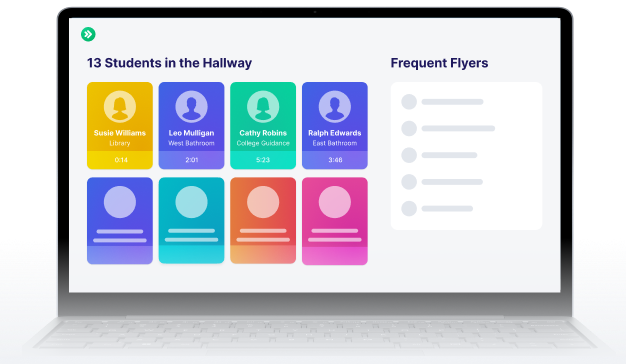In the News: Enhancing Safety in Schools Across Minnesota
Read the Story
SmartPass Co-Founders Listed on Forbes 30 Under 30
Read the Story

Lee Moskowitz
.avif)
.jpg)
Vaping remains a pressing concern in schools across the United States. While tobacco use among youth has seen an overall decline, e-cigarettes continue to be the most commonly used tobacco product among middle and high school students. According to the 2024 National Youth Tobacco Survey, 7.8% of high school students (approximately 1.21 million teens) and 3.5% of middle school students (410,000) reported current e-cigarette use. Among those who vape, over 26% reported using e-cigarettes daily, suggesting that many students are developing patterns of frequent or even habitual use.
These trends raise concerns for educators, not only because of the well-documented health risks—including nicotine addiction and respiratory issues—but also because vaping often disrupts learning environments. Students frequently leave class to vape, and many incidents occur in restrooms, locker rooms, and unsupervised areas of campus. Consequently, a large focus area for school administrators is how to stop vaping in schools.
For school principals, addressing vaping involves far more than just enforcing disciplinary policies. It requires a coordinated response that includes prevention education, parent involvement, health support, and the right tools. In this blog, we’ll examine how school leaders are tackling the issue on multiple fronts and share insights directly from principals who are navigating this challenge every day.
Vaping presents more than just a disciplinary issue for schools—it’s a serious health concern. Research has shown that nicotine exposure during adolescence can interfere with brain development, particularly in areas related to attention, learning, and mood regulation. According to the National Institute on Drug Abuse, early nicotine use is also linked to increased risk of anxiety, depression, and later substance use disorders.
In addition to cognitive and behavioral impacts, vaping has been associated with significant respiratory health risks. The American Lung Association warns that e-cigarette use can cause lung inflammation and, in some cases, permanent lung damage. These risks underscore why schools are actively investing in prevention, early intervention, and support systems for students who vape.
Principals play a critical role in defining their schools’ stance on vaping. Their responsibilities extend beyond simply enforcing the rules; they must set clear expectations, educate students, and engage parents in the conversation.
To effectively combat vaping, schools need to understand why students start in the first place. Research has shown that the most common reasons for adolescent vaping include:
This is why many educators believe punishment alone is not the answer. Without addressing the underlying reasons students vape, suspensions and fines won’t stop the cycle.
Principals across the country are responding to vaping with a layered, comprehensive set of strategies—blending technology, curriculum, discipline, and partnerships. Here's how they’re doing it in their own words:
Some schools are applying multiple layers of deterrence and support to tackle vaping from every angle. Zachary Bolen, Assistant Principal at Owen County High School (KY), shares his comprehensive approach:
“Many schools, including mine, take a multi-faceted approach to addressing vaping. Some of the key programs and policies we have implemented include:
Principals are implementing structured educational programs to prevent vaping before it starts. Laura Jennaro, Principal at Butler Middle School of the Waukesha School District (WI), described:
“Too Good for Drugs is a 10 week grant funded program that all students in our entire school participate in as a Tier 1 curriculum that is unique to each grade level. Trained instructors lead the lessons with classroom teachers supporting the work. For Tier 2 we bring in High school students to share a program called "Escape the Vape" for 8th graders. Any students who are apprehended with a vape device completes an online (self paced) Tier 3 program called Aspire which is grant funded. Students enrolled in ASPIRE have to complete before returning to class. I believe this thorough and consistent programming has significantly reduced the use of vaping devices over the past few years.”
This program reflects how prevention and discipline can work together to create long-term behavior change.
At Eisenhower High School (OH), Andrea Tracy is also using ASPIRE "We use the ASPIRE program from MD Anderson. Students who are caught vaping are assigned the course and must complete it before returning to class. We’ve found it helps reinforce the health risks in a more personal and scientific way."
While policies and punishments are often emphasized, the physical and social environment of a school can play a major role in shaping student behavior—especially when it comes to vaping.
At Khalil Gibran International Academy (NY), Principal Amanda Hunter has taken a well-rounded, environmental approach to prevention, making sure that students are surrounded by consistent messages and fewer opportunities to engage in risky behavior.
"We have bulletin boards set up with information on quitting and the effects of vaping."
These visual reminders—placed strategically around the school—reinforce the risks and encourage reflection. But Hunter’s strategy goes deeper than signage.
"We have a SAPIS [Substance Abuse Prevention and Intervention Specialist] who does push-in lessons as well as individual counseling."
This provides students with accessible, in-school support that addresses the emotional and behavioral roots of substance use. Whether it’s classroom instruction or one-on-one guidance, students have a trusted adult to turn to.
Hunter and her team are also highly aware of the physical spaces where vaping tends to occur:
"We monitor arrival and dismissal and actively discourage students from vaping anywhere on the school's perimeter. We have signage in stairwells and on bathroom doors."
Vaping often happens just outside the school’s line of sight—bathrooms, stairwells, or around campus boundaries. By monitoring those zones and reinforcing expectations, the school reduces “gray areas” where rules are often bent.
Finally, Hunter notes that they’ve adopted SmartPass as a tool to limit unsupervised meetups:
"We brought on SmartPass to decrease meetups for vaping."
This shows how managing student movement—especially during unscheduled times—can reduce opportunities for vaping without resorting to harsh surveillance or punitive measures.
Taken together, these strategies reflect a powerful principle: prevention isn’t just about what you say—it’s about what students see, where they go, and who they can talk to.
Discipline still plays a role, but many schools are pairing consequences with learning. Brianne Parks, Principal at Southern Huntingdon County High School/Middle School (PA), explained:
“Students get In- School- Suspension and they get a fine (citation) with the district magistrate.
We are now doing a smokeless- Saturday where students are only paying a 1/3 of what the fine (citation) is and they have to complete it on a Saturday. It is an interactive course that is about 3.5 hours.”
This approach focuses on consistency in enforcement while using the moment as a learning opportunity.
Joanne Bohrman, Principal at Lehman Intermediate School (PA), explained how her school weaves discipline with due process:
"If our administration becomes aware of students vaping, we conduct an investigation. Students found in violation of our policy are disciplined appropriately and also referred to our Student Assistance Program team. The SAP team meets with the student and family to provide support and resources, including referrals to external services when necessary.
Our Code of Student Conduct prohibits vaping and vaping items on campus with a consequence of suspension time and the completion of a course about the hazards of vaping. Any students violating this policy get referred to the Student Assistance Program, in which we reach out to parents and students regarding further support for the student, including group and individual counseling regarding substance abuse and associated health risks.
At Valliant Middle School (OK), Principal Aaron Beshears described a proactive role in using vape detectors for schools.
"I monitor vape detectors, have metal detectors to wand students who have been caught or said to have a vape. I discipline students who are caught vaping. I also assist with scheduling seminars and programs to combat vaping."
His approach shows how technology, direct supervision, and education events can work in tandem. Notably, Valliant Middle also refers students to local support:
"We recommend students take the first-time offenders program with the county youth services."
This blend of in-school enforcement with external resources helps create more restorative pathways for students, especially those who may be struggling with nicotine dependence.
While many schools are making progress, there is still more work to be done. Some additional strategies experts recommend include:
The vaping problem won’t be solved overnight, but schools that take a proactive, multi-layered approach will see the greatest success. By combining education, enforcement, and support, school leaders can help curb the rise of vaping and create healthier learning environments for students.
The rise in student vaping is a complex issue—but schools are not powerless. Across the country, principals are leading the charge with proactive strategies that combine education, consistent enforcement, community engagement, and support for students who need help quitting.
What’s clear from their stories is that there is no one-size-fits-all solution. But when schools approach vaping with clarity, compassion, and coordination, real progress is possible. By designing environments that discourage risky behavior and empower students to make informed choices, school leaders are not just reacting to a trend—they're building safer, healthier cultures.
The path forward will require persistence, innovation, and continued collaboration among educators, families, and health professionals. But schools that stay committed to prevention and accountability are already showing that change is not only necessary—it’s achievable.


.jpg)
